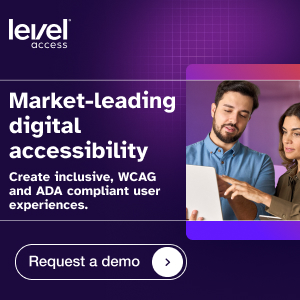Why Contrast Checkers Matter for Web Accessibility

Ensuring proper color contrast is vital when creating accessible websites. A fundamental part of any web designer’s accessibility toolkit, a contrast checker makes it easy to ensure digital content is readable for the broadest possible group of users.
Why use a contrast checker?
A contrast checker is more than just a color validation tool—it’s an essential instrument for creating inclusive digital experiences. These tools help designers and developers ensure their content meets accessibility standards while maintaining visual appeal. Key benefits of using a contrast checker in web design include:
- Immediate feedback on color choices
- Prevention of contrast-related accessibility issues early in design
- Confidence in meeting Web Content Accessibility Guidelines (WCAG) standards
Providing sufficient color contrast, with the help of a contrast checker, also benefits users. For users with certain disabilities, including low vision and color blindness, proper contrast can be critical to content accessibility. However, implementing a high contrast color scheme ultimately enhances user experience for everyone by making text easier to read, reducing eye strain, and improving content comprehension.
Understanding contrast in web design
Contrast refers to the difference in luminance between foreground elements (e.g., text, UI components) and background colors. Proper contrast ensures content is readable for all users, including those with low vision or color blindness.
WCAG guidelines specify minimum contrast ratios for accessibility:
- 4.5:1 for normal text
- 3:1 for large text (18pt or 14pt bold)
- 3:1 for UI components and graphical objects
A reliable color contrast checker automatically performs these calculations, saving designers time while ensuring accuracy. This is why accessibility experts emphasize the importance of using a color contrast checker during the design process.
Essential features of contrast checkers
A number of color contrast checkers are freely available on the web. These include WebAIM’s Contrast Checker, and the Level Access Color Contrast Checker. Most of these popular tools offer the following features:
- Real-time color contrast analysis through instant contrast ratio calculation
- WCAG conformance verification, indicating whether a color combination passes or fails WCAG criteria
- Suggested accessible color alternatives, with visual previews
Advanced tools are also available for those seeking more sophisticated features, such as bulk color analysis and pattern contrast checking. These tools typically require a paid subscription or contract.
Integration with ADA compliance checker tools
Color contrast analysis is often one capability of a broader digital accessibility solution set that also includes an automated testing tool, sometimes called an “ADA compliance checker.”
Automated testing engines can scan entire websites for common accessibility issues, including insufficient color contrast, and provide remediation suggestions. Some digital accessibility platforms with automated testing capabilities also allow website owners to monitor accessibility progress over time and generate detailed reports on their conformance status.
Best practices for designing with sufficient contrast
Designing digital experiences that meet color contrast standards starts with a contrast checker, but it doesn’t end there. Here are best practices for creating readable content:
- Test early and often: Check every new color combination for accessibility.
- Document color choices: Document accessible color combinations that align with your brand’s identity for future use.
- Create accessible color palettes: Choose color palettes that support high-contrast color combinations.
- Consider multiple viewing conditions: Ensure color contrast is sufficient for users viewing content in different situations, including in bright sunlight.
- Test with real users: Engage people with disabilities to provide feedback on the readability of content.
When implementing designs, development and quality assurance (QA) teams should take additional steps to validate color contrast, including:
- Checking that color contrast for interactive elements like buttons remains adequate when these elements are in different states.
- Verifying that color combinations support accessibility across devices, including tablets and mobile phones.
- Ensuring accessible color combinations are applied consistently throughout a digital experience.
Common contrast mistakes to avoid
When it comes to enhancing web accessibility, addressing color contrast issues is often one of the fastest—and easiest—improvements teams make. However, it’s important to avoid making these common missteps:
- Relying on color alone: Contrast isn’t the only consideration to bear in mind when it comes to the accessible use of color.
To conform with WCAG, designers should never use color alone to communicate meaning.
Always incorporate multiple indicators, including patterns, icons, or text labels.
If you’re unsure whether the meaning of an element is clear without color, test it in grayscale.
- Overlooking interactive elements: Color contrast issues often emerge in interactive elements, like buttons and form fields. Always check color contrast for interactive elements in every state, including hover and disabled states, and verify that focus indicators meet contrast requirements. When building forms, validate that form error messages and success indicators use adequate contrast ratios.
Incorporating contrast in design systems
Many modern design teams rely on design systems to create consistent brand experiences at scale. And incorporating accessibility best practices, like sufficient color contrast, into your organization’s design system is a powerful step toward streamlining accessible design at your organization. You can start building accessible color application into your design system by:
- Creating pre-approved color combinations.
- Documenting contrast requirements.
- Providing testing procedures.
- Maintaining color libraries.
- Updating guidelines regularly.
Designing a more accessible digital world
Applying accessible color combinations removes barriers for users with disabilities, and it ultimately benefits everyone. Proper contrast improves reading speed, boosts information retention, and makes navigation and task completion more efficient. All of these factors lead to higher overall user satisfaction.
Contrast checkers make it easy for designers and developers to rapidly evaluate and validate color combinations. And as technology evolves, contrast checkers will likely become even more sophisticated, offering additional features like context-aware testing.
Testing—and implementing—inclusive color schemes is a critical step toward creating experiences that not only look beautiful but work for everyone. Remember that accessibility isn’t a constraint on creativity, but an opportunity to innovate and craft universal designs. After all, the most effective digital experiences are those that all users can perceive, understand, and navigate with ease.
Related Posts
Automated Remediation: Accelerating Digital Accessibility
Digital accessibility isn’t just about compliance—it’s about ensuring everyone can access and interact with web content effectively. As organizations aim to improve user experience across...
Understanding the VPAT: A Complete Guide to Accessibility Documentation in 2025
Imagine you’re purchasing a used car. Before you sign the papers, you’ll probably want confirmation that it’s been inspected by a mechanic, so you know...
Comprehensive Guide to Accessibility Checkers & Inclusion
In today’s digital landscape, ensuring website accessibility isn’t just a recommendation—it’s a necessity. Automated testing solutions, also known as accessibility checkers, serve as crucial tools...
